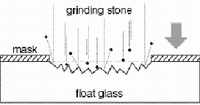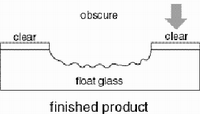Section 1
The TAPESTRY Process
Appendix (A) illustrates the sequence of FIGLA's process. The substrates to be treated are usually AN clear, low iron or tinted float glass, including some of the pyrollitic and vacuum sputtered coated products. Two standard levels of obscuration density have evolved following years of experimentation - these are standard MATTE finish, which offers comprehensive concealment of nearby objects from the viewer and a relatively rough surface, and standard SOFT MATTE, which offers less obscuration but a finer satin-like grain surface.
TAPESTRY surfaces differ from ordinary sandblasted, acid etched or mechanically abraded glass surface. The superior density and uniformity of TAPESTRY is evident as compared with other obscuring finishes. Sandblasting, as shown in the first phase of TAPESTRY processing (see Appendix (A)), leaves a surface which can be described as "steep hills and valleys". Such surfaces are susceptible to staining from fingerprints and other common spills, and discolor readily if exposed to humidity. Even the subsequent application of sprayed protective films only protects the surfaces temporarily from eventual deterioration.
The second phase of the TAPESTRY process involves the use of hydrofluoric and other strong acids, which graphically (see Appendix (A)) produce a smoother surface akin to "rolling hills". This finish is highly resistant to staining when appropriately maintained, and requires no additional film overcoat. It can even be used as a walking surface, with appropriate grid pattern designs, for indoor and outdoor use. The use of toxic acids was faced by FIGLA from the inception of TAPESTRY some 20 years ago. The Japanese equivalent of EPA and OSHA are just as strict in their requirements for protecting the workers, the public and the environment as in the U.S., so FIGLA built a re-cycling facility to successfully eliminate all of these risks. The product itself is, of course, extensively rinsed with re-cycled water before shipping, so there is no residue to concern the customer. The uniformity extends to TAPESTRY applications as large glass lites; it is sometimes possible to offer standard uniform MATTE finish in sizes up to 3m x 7m (9'6"x 22'11"). Uniformity both within a lite and from lite to lite, is also evident as compared with other similar products.
Maintenance of TAPESTERY surfaces can usually be accomplished with plain water, But mild detergents, followed by clean water rinsing are also acceptable. A special Manual for patterned TAPESTRY products and glass floor or stair tread pavers are available upon request.
The FIGLA "TAPESTRY" Etching Process
1. Uniform Obscuration - Standard MATTE & Soft MATTE Finishes
2. Custom Patterns - Lines, Dots, Lozenges, Etc.
3. Custom Lettering & Artwork (including Hand Carving)

|
1. MASKING |
|

|
2. SANDBLASTING |
|

|
3. ACID WASHING |
|

|
4. FINAL RINSE & MASK REMOVAL |
